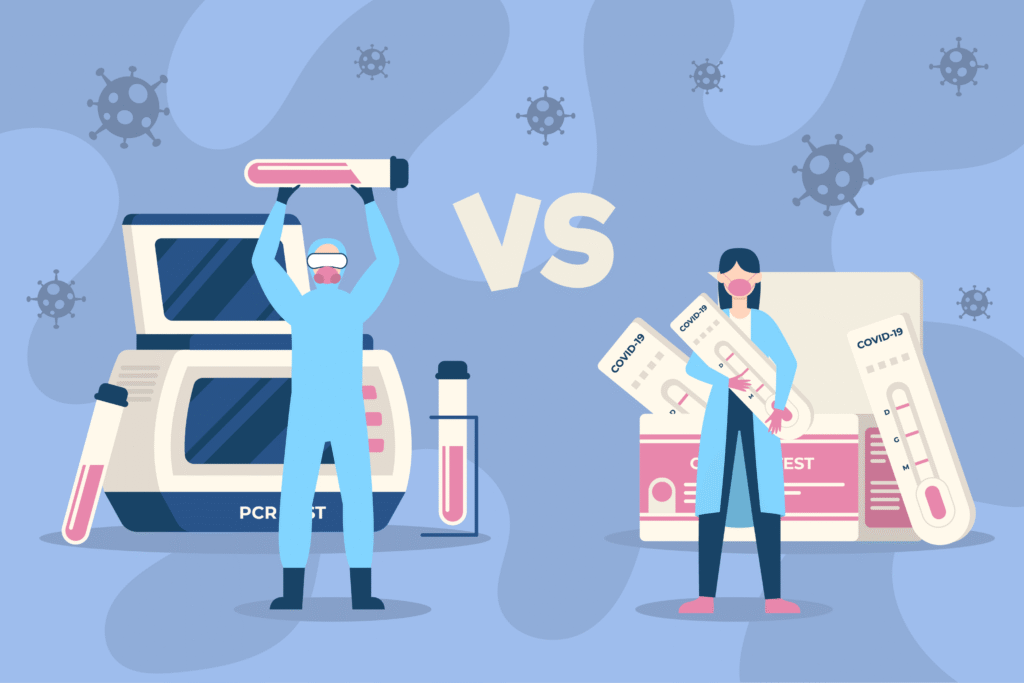
In discussions about diagnostic reliability, we tend to focus on false positives. However, when time is critical — as in rapid infection tests, prenatal screenings, or acute biomarkers — the real blind spot lies at the opposite end: the
The studies we reviewed (NEJM, CDC, immunoassay analyses, and the largest NIPT review to date > 750,000 cases) reveal a consistent pattern: false negatives are less visible, but far more consequential.
TL;DR
False negatives are the greatest hidden risk in rapid tests and screenings because they create a false sense of security. Unlike false positives, which are usually detected and confirmed, a false negative goes unnoticed and can delay treatments, promote contagion, and distort clinical decisions. The “real” sensitivity of a test depends on the context (pre-test probability, sample quality, stage of disease), so a negative is never a definitive “does not have it,” but rather a reduction in probability. To minimize errors, it is essential to interpret results with a risk-management mindset, consider predictive value, understand pre-analytical limitations, and repeat testing if clinical suspicion remains high. In rapid diagnostics, closing a case too early is far more dangerous than confirming it twice.
The core issue: Ruling out is always more delicate than confirming
In clinical diagnostics, a false positive is usually detected because it triggers an immediate reaction: it forces repeat testing or confirmatory methods. It is inconvenient, but visible.
A false negative is different: it triggers no warning. The result appears normal, and the clinical process continues with no reason for anyone to suspect an error.
This is clearly explained in an analysis published in The New England Journal of Medicine on COVID-19. The authors note that an infected patient with a negative result may remain without isolation, continue interacting with others, and unknowingly transmit the infection.
The CDC describes a similar situation with influenza. Rapid influenza diagnostic tests (RIDTs) show a sensitivity of 50–70%, meaning false negatives are common, particularly when the virus is circulating widely in the community.
When clinical decision-making depends on ruling out a disease—for example, to end isolation, avoid further testing, or dismiss a diagnosis—a false negative has greater impact than a false positive, because it may lead to assuming that no problem exists when in fact it does.
Why false negatives occur
Although false negatives may seem like a simple test failure, evidence shows that there is almost never a single cause. What matters is not only knowing these causes—well documented in the literature—but understanding how they alter diagnostic certainty and why they are so difficult to detect in clinical practice.
Several contributing factors often overlap and amplify one another, which explains why false negatives tend to appear precisely at the moments when clinical decision-making depends most on a careful, high-stakes interpretation.
Tests are designed to coexist with error
No test is perfect. There is always a balance between sensitivity and specificity. When a system prioritizes “not over-treating” (avoiding false positives), the risk of false negatives inevitably increases. This is especially clear in immunoassays and screening programs: small error rates are accepted because the cost of confirming a positive result is manageable.
“Real” sensitivity is not a fixed number—it’s a range
In respiratory infections, for example, false-negative rates have been reported from very low percentages up to 30–40%, depending on:
-
The type of specimen
-
The day of illness
-
The sampling technique

And with influenza, a similar pattern appears: under ideal conditions rapid tests seem acceptable, but during peak season the probability that a negative result is wrong increases significantly.
Eso significa que no podemos interpretar un negativo como si el test tuviera siempre su “mejor” sensibilidad. El rendimiento que importa es el de ese entorno concreto.
The system detects false positives far better than false negatives
A false positive generates noise: doubts, repeat testing, discussion. It draws attention and ends up being documented.
A false negative, if the patient does not return with obvious problems, is never discovered.
In NIPT this is particularly clear: false positives are well quantified, but negatives are rarely followed up. This distorts perception and makes the issue appear minimal, when in reality it is under-measured.
The weakest part is not the test itself, but everything that happens before the test
Data from COVID, influenza, and other examples all point in the same direction. The type of sample and how it is collected matter far more than it may seem. If the sample does not accurately represent the biology of the process (low viral load, wrong anatomical site, poor technique), no test—no matter how sophisticated—can “guess” what is not present in the sample.
False negatives are not rare accidents; they are the logical consequence of how tests are designed, how we use them, and how little visibility we have of errors that lean toward the “reassuring” side.
What changes in clinical practice when we understand this?
The next step is not to keep accumulating numbers, but to ask: What would a clinician or manager actually do differently if they truly internalized this?
A negative does not answer “yes/no”; it answers “how much less likely”
The mental model many professionals use is binary:
Positive = the patient has it
Negative = the patient does not have it
What the data are actually telling us is something different. A negative result only means “it is now less likely that the patient has the condition.”
How much less likely depends on:
-
The pretest probability (clinical suspicion, epidemiological context)
-
The real-world sensitivity of that test in that environment
-
The severity of being wrong if the patient does have the condition
If the clinical picture is highly compatible, during peak season, and the test’s sensitivity is known to drop under real-life conditions, a negative result lowers the probability… but not enough to act as if it were zero.
This is the rationale behind recommendations such as “repeat the test if clinical suspicion remains high.”

Decision-making is not only clinical — it is also risk management
Work on healthcare management and clinical pharmacy explains this clearly: false positives and false negatives do not carry the same cost.
-
A false positive usually involves: more tests, more costs, increased anxiety, some degree of overtreatment.
-
A false negative can involve: avoidable admissions, complications, transmission, litigation, and loss of trust
If we think of this as a risk-management issue, the question is no longer just “What is the sensitivity?” but rather:
-
What am I willing to assume in this specific context?
-
Which error can I afford more: overtreating or undertreating?
In emergency departments evaluating chest pain, for example, the system generally tolerates a small excess of testing better than the risk of sending a heart attack patient home. In contrast, in large-scale screening programs, more false positives tend to be accepted because there is a second confirmatory layer.
The way results are communicated is almost as important as the result itself
All this body of evidence points to an uncomfortable issue: the way we communicate a “negative” is often misleading.
In NIPT, for example, many patients interpret a negative as “the baby is fine,” when technically it means “the probability of certain specific anomalies is low, but not zero, and it does not rule out many other possible conditions.” If this nuance is not explained, a false negative breaks an expectation of certainty that the test never promised.
In acute infection, something similar happens. Simply stating “the test is negative” without adding context (type of test, sensitivity, timing of sample collection, pre-test probability) invites clinicians to overtrust the result.
So it is not enough to improve the tests; we must improve the language used to interpret negative results and always keep present what both a positive and a negative truly mean.
How the interpretation of a “negative” should change based on all this
What was the probability before the test?
A negative does not carry the same meaning in:
-
A patient with mild symptoms in a low-prevalence situation
-
Someone with highly suggestive clinical features in the middle of an epidemic wave
In the second case, the pretest probability is so high that a single negative result from a test with limited sensitivity is not enough to close the case. Here, it becomes clear that the higher the clinical suspicion, the less weight an isolated negative carries.
What do I know about the real sensitivity of this test in this scenario?
Not the sensitivity from the package insert, but the one observed in real life.
-
Do I know that the rapid test I’m using has many false negatives during peaks of circulation?
-
Do I know that this assay is less sensitive with certain sample types or disease stages?
-
Do I know that this facility frequently has pre-analytical issues?
If the answer is yes to any of these, a negative automatically drops in reliability — and it can no longer be a strong argument for ruling out the condition.
In the end, understanding false negatives is not about memorizing percentages or comparing which test has slightly higher sensitivity. It is about recognizing that any negative result exists within a clinical context that moves, shifts, and sometimes misleads. If all these data—from respiratory infections to prenatal screening—show anything, it is that tests do not fail only because they are imperfect, but because we use them in imperfect scenarios: patients who arrive late, samples that do not capture what we are looking for, validations that do not reflect real life, and systems that detect errors confirming a problem far better than those that dismiss one.
That is why, rather than obsessing over the exact sensitivity figure, what truly changes practice is treating every negative as one more piece of the puzzle—not as the final word. When interpreted this way, many of the problems associated with false negatives stop being “test failures” and become better decisions.
Closing the door too soon is always more dangerous than checking it twice. That, in essence, is the message that ties all these studies together. And it is also the idea that should guide the interpretation of any negative in rapid diagnostics—not as a full stop, but as an invitation to look a little more closely.